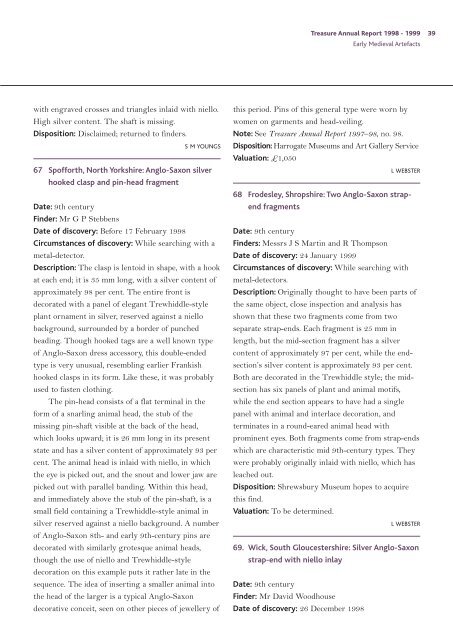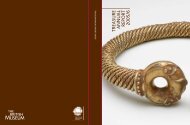Treasure Annual Report 1998-1999 - Portable Antiquities Scheme
Treasure Annual Report 1998-1999 - Portable Antiquities Scheme
Treasure Annual Report 1998-1999 - Portable Antiquities Scheme
You also want an ePaper? Increase the reach of your titles
YUMPU automatically turns print PDFs into web optimized ePapers that Google loves.
with engraved crosses and triangles inlaid with niello.<br />
High silver content. The shaft is missing.<br />
Disposition: Disclaimed; returned to finders.<br />
S M YOUNGS<br />
67 Spofforth, North Yorkshire: Anglo-Saxon silver<br />
hooked clasp and pin-head fragment<br />
Date: 9th century<br />
Finder: Mr G P Stebbens<br />
Date of discovery: Before 17 February <strong>1998</strong><br />
Circumstances of discovery: While searching with a<br />
metal-detector.<br />
Description: The clasp is lentoid in shape, with a hook<br />
at each end; it is 35 mm long, with a silver content of<br />
approximately 98 per cent. The entire front is<br />
decorated with a panel of elegant Trewhiddle-style<br />
plant ornament in silver, reserved against a niello<br />
background, surrounded by a border of punched<br />
beading. Though hooked tags are a well known type<br />
of Anglo-Saxon dress accessory, this double-ended<br />
type is very unusual, resembling earlier Frankish<br />
hooked clasps in its form. Like these, it was probably<br />
used to fasten clothing.<br />
The pin-head consists of a flat terminal in the<br />
form of a snarling animal head, the stub of the<br />
missing pin-shaft visible at the back of the head,<br />
which looks upward; it is 26 mm long in its present<br />
state and has a silver content of approximately 93 per<br />
cent. The animal head is inlaid with niello, in which<br />
the eye is picked out, and the snout and lower jaw are<br />
picked out with parallel banding. Within this head,<br />
and immediately above the stub of the pin-shaft, is a<br />
small field containing a Trewhiddle-style animal in<br />
silver reserved against a niello background. A number<br />
of Anglo-Saxon 8th- and early 9th-century pins are<br />
decorated with similarly grotesque animal heads,<br />
though the use of niello and Trewhiddle-style<br />
decoration on this example puts it rather late in the<br />
sequence. The idea of inserting a smaller animal into<br />
the head of the larger is a typical Anglo-Saxon<br />
decorative conceit, seen on other pieces of jewellery of<br />
<strong>Treasure</strong> <strong>Annual</strong> <strong>Report</strong> <strong>1998</strong> - <strong>1999</strong> 39<br />
Early Medieval Artefacts<br />
this period. Pins of this general type were worn by<br />
women on garments and head-veiling.<br />
Note: See <strong>Treasure</strong> <strong>Annual</strong> <strong>Report</strong> 1997–98, no. 98.<br />
Disposition: Harrogate Museums and Art Gallery Service<br />
Valuation: £1,050<br />
L WEBSTER<br />
68 Frodesley, Shropshire: Two Anglo-Saxon strapend<br />
fragments<br />
Date: 9th century<br />
Finders: Messrs J S Martin and R Thompson<br />
Date of discovery: 24 January <strong>1999</strong><br />
Circumstances of discovery: While searching with<br />
metal-detectors.<br />
Description: Originally thought to have been parts of<br />
the same object, close inspection and analysis has<br />
shown that these two fragments come from two<br />
separate strap-ends. Each fragment is 25 mm in<br />
length, but the mid-section fragment has a silver<br />
content of approximately 97 per cent, while the endsection’s<br />
silver content is approximately 93 per cent.<br />
Both are decorated in the Trewhiddle style; the midsection<br />
has six panels of plant and animal motifs,<br />
while the end section appears to have had a single<br />
panel with animal and interlace decoration, and<br />
terminates in a round-eared animal head with<br />
prominent eyes. Both fragments come from strap-ends<br />
which are characteristic mid 9th-century types. They<br />
were probably originally inlaid with niello, which has<br />
leached out.<br />
Disposition: Shrewsbury Museum hopes to acquire<br />
this find.<br />
Valuation: To be determined.<br />
L WEBSTER<br />
69. Wick, South Gloucestershire: Silver Anglo-Saxon<br />
strap-end with niello inlay<br />
Date: 9th century<br />
Finder: Mr David Woodhouse<br />
Date of discovery: 26 December <strong>1998</strong>





